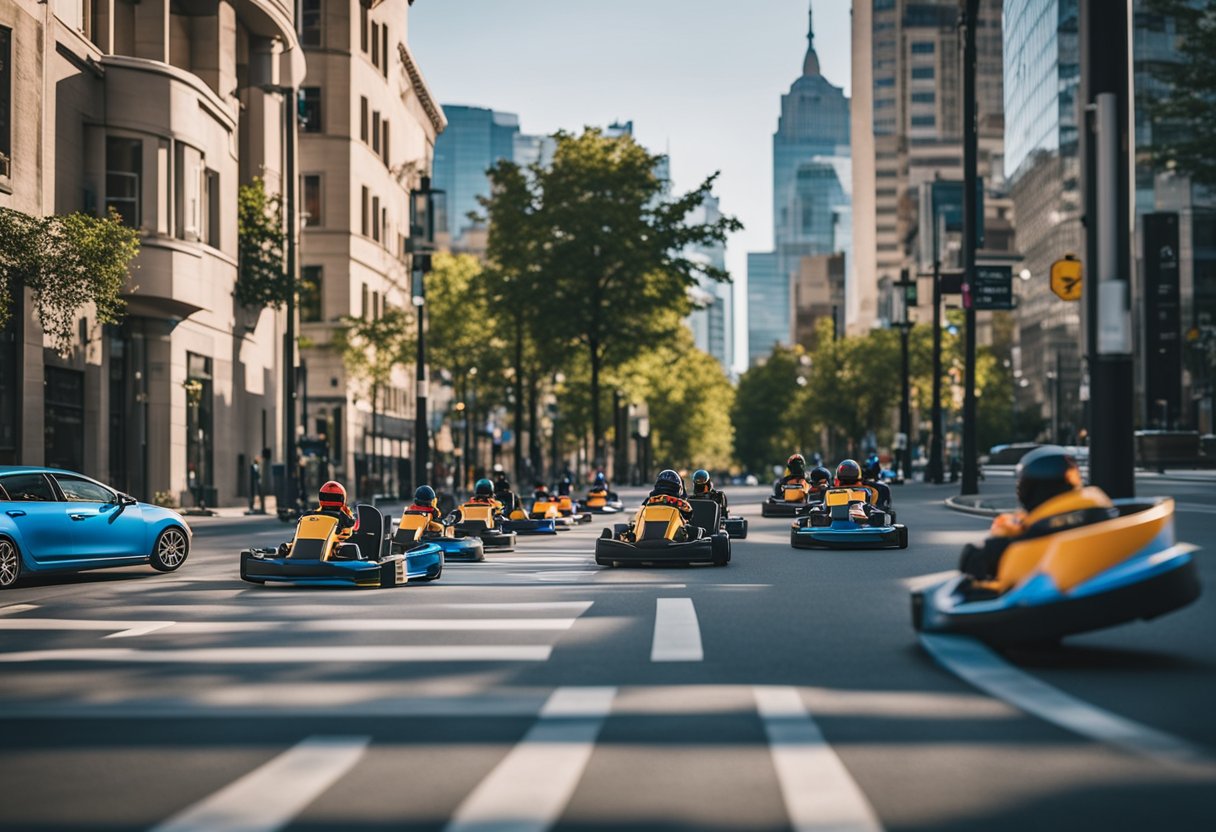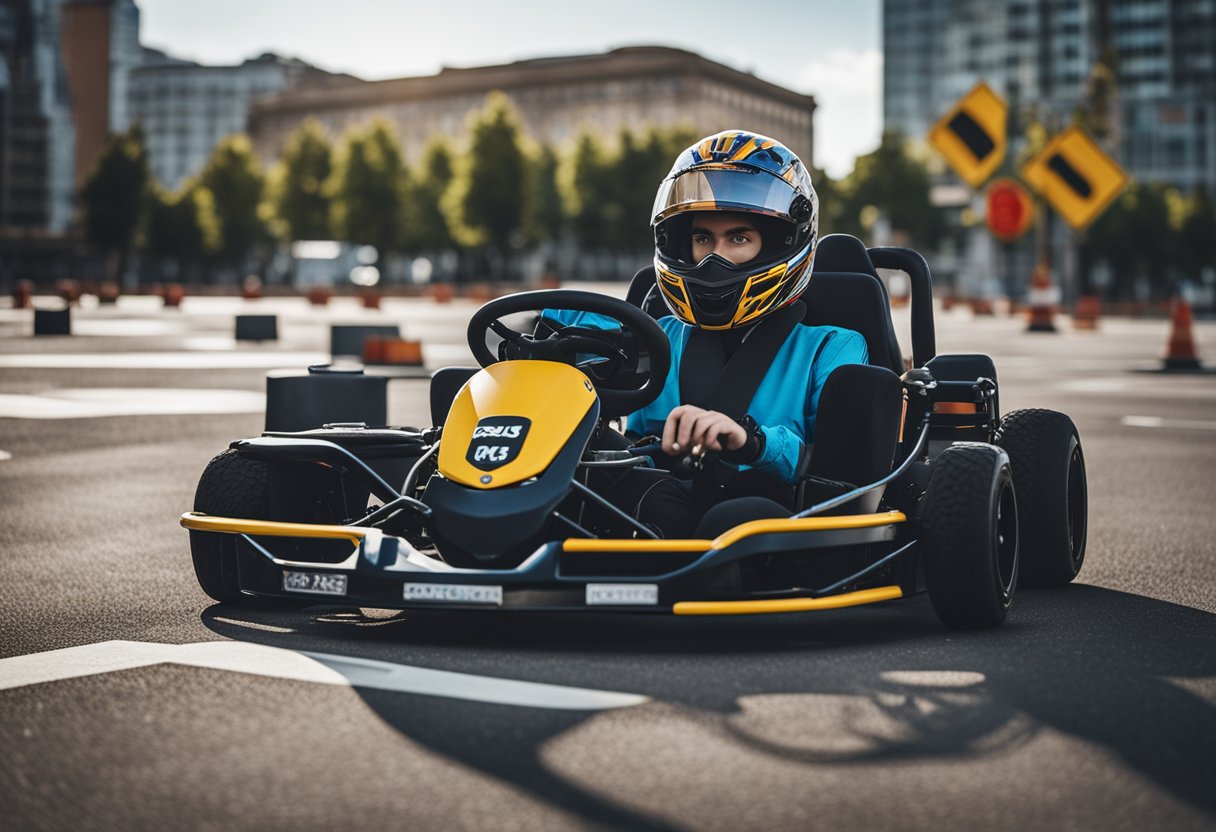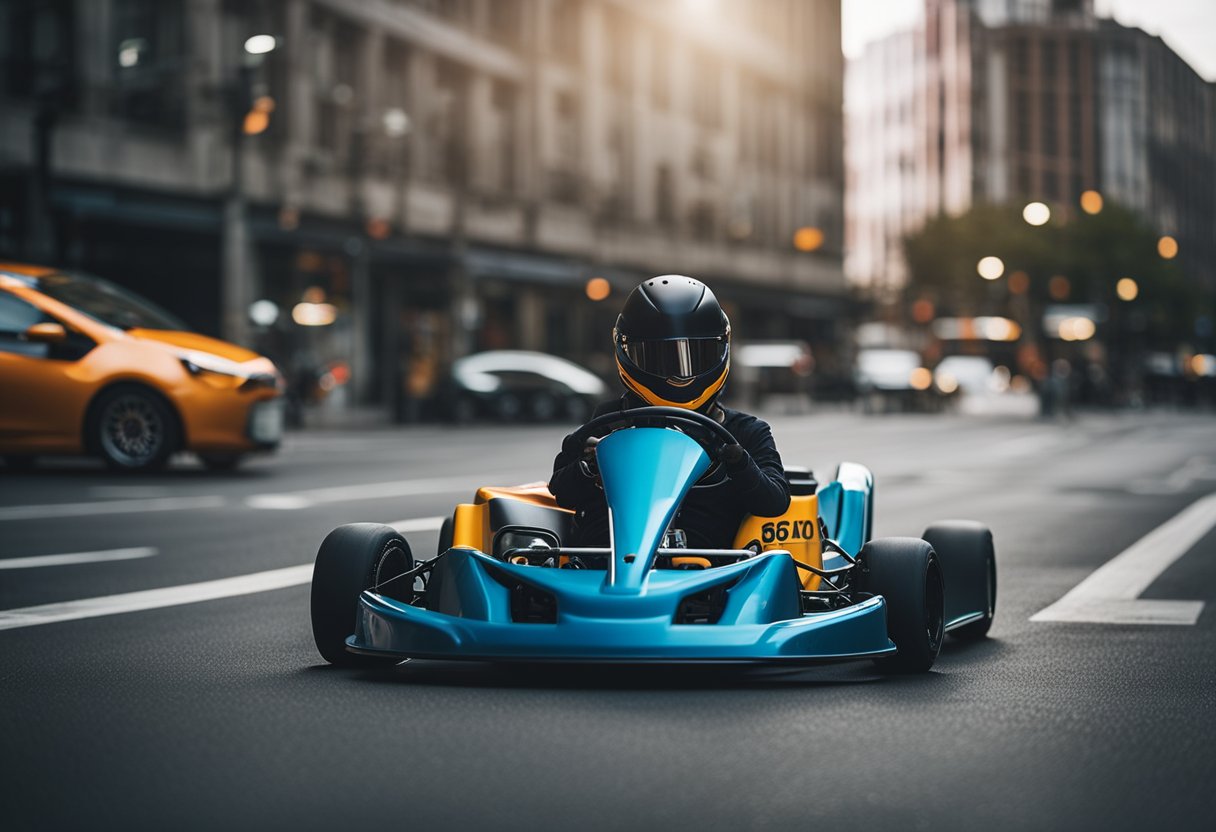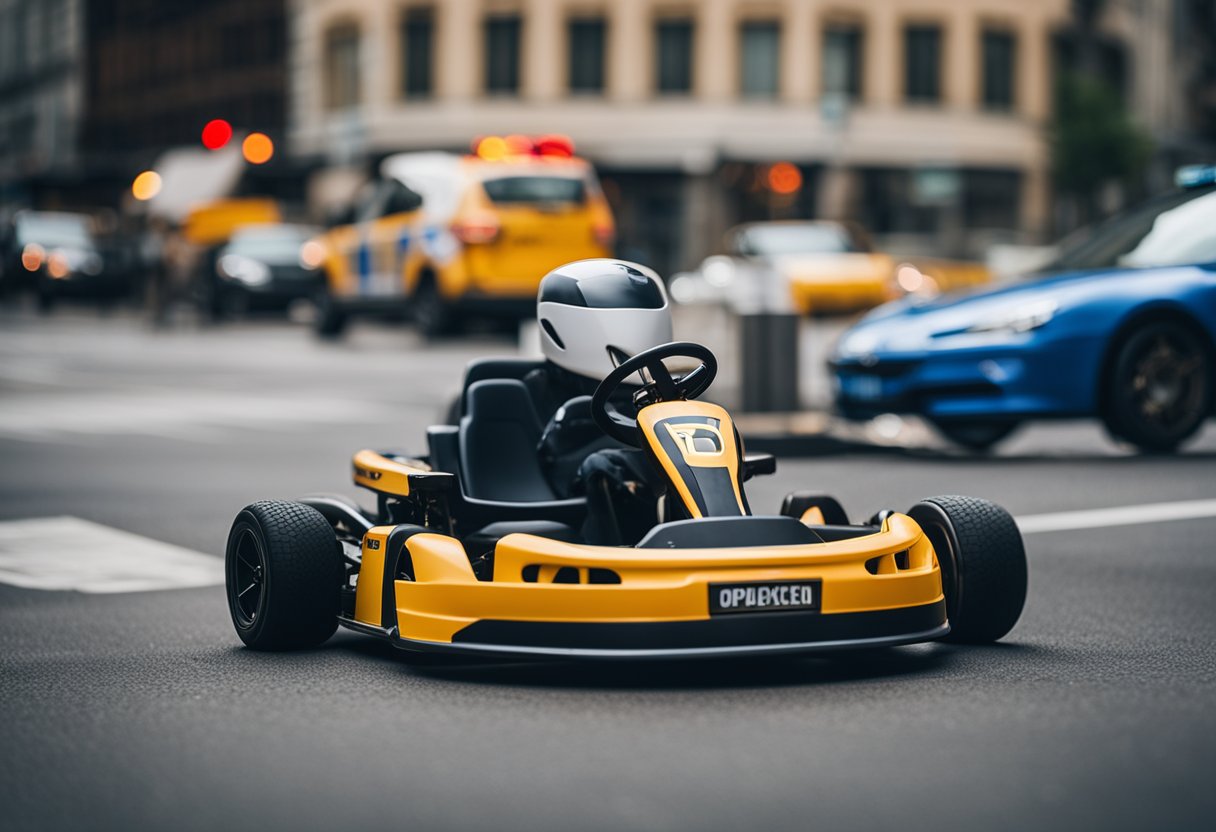When contemplating the thrill of go-karting, a common question arises: Can go-karts be street legal? The answer varies, as street legality for go-karts is not a straightforward ‘yes’ or ‘no’. It primarily depends on the state’s regulations and the specific modifications made to the go-kart to meet those standards. By design, most go-karts lack the necessary features for safe operation on public roads, as they are built for racing or off-road enjoyment.

Converting a go-kart into a street-legal vehicle entails meeting a series of requirements, such as installing safety equipment like seat belts, turn signals, and a horn.
Additionally, the kart must pass an inspection to be registered with the state’s Department of Motor Vehicles (DMV). Once registered, you will also need to consider insurance and liability to protect yourself in case of accidents or injuries.
Key Takeaways
- Go-kart street legality is conditional and regulated by individual states.
- Modifications must comply with safety and equipment standards for public road use.
- Registration and insurance are mandatory for street-legal go-karts.
Go-Kart Basics

In exploring the world of go-karts, it’s crucial to understand their fundamental characteristics and the components that comprise these unique vehicles.
Definition and Types
A go-kart, often called a go-cart, is a small, low-slung vehicle designed primarily for recreational use or racing, with models built for different environments and purposes. You’ll find off-road go-karts which are constructed to handle rough terrain and unpaved tracks. Conversely, racing go-karts are streamlined for speed and efficiency on racetracks.
Components of a Go-Kart
Every go-kart consists of several key components that play vital roles in their operation and performance:
- Chassis: The core frame of the go-kart, typically made of steel tubes for durability and flexibility.
- Engine: Provides the power to the go-kart; can vary in size and type depending on the go-kart model.
- Tires: Specifically designed for the go-kart’s operating environment whether it be off-road or on a racetrack.
- Brakes: Essential for safety, allowing you to slow down or stop the go-kart.
- Steering: Typically a direct steering system for responsive control.
- Seat Belt: A crucial safety feature to keep you secured in the seat.
In addition to these, a street-legal go-kart may require certain features like mirrors, a windshield, a horn, appropriate lights, a speedometer, and more, depending on the state’s regulations.
Here’s a checklist for a street-legal go-kart:
- Adequate Braking System
- Functioning Tail Lights and Headlights
- Mirrors for visibility
- Windshield (if not wearing a helmet with a visor)
- Audible Horn
- Visible Turn Signals
- Speedometer to display driving speed
- Proper Seat Belts
Understanding these basics and components gives you an insight into what makes up a go-kart and the potential requirements for making one street-legal.
Regulatory Considerations

Before attempting to make your go-kart street legal, it’s crucial to understand the regulations that apply to Low-Speed Vehicles (LSVs) and how they differ across various jurisdictions in the United States.
Understanding LSVs
An LSV, or Low-Speed Vehicle, is a category under United States federal law that includes vehicles with a top speed of more than 20 mph but less than 25 mph. LSVs are required to have specific safety features such as:
- Headlamps
- Tail lamps
- Stop lamps
- Front and rear turn signals
- Reflectors
- Mirrors
- Parking brakes
- Windshield
- Vehicle identification number (VIN)
Moreover, the Department of Motor Vehicles (DMV) mandates that all LSVs must be registered, have a valid license plate, and the drivers must have liability insurance.
Local and State Regulations
The legality of LSVs, including go-karts, can vary significantly across state lines.
This means regulations that apply in California may not be the same in Florida. Each state has its unique set of statutes governing the operation of LSVs on public roadways.
The various states such as Arizona, New Hampshire, and Texas could demand additional requirements or offer specific concessions. For example, some Local Authorities might allow LSVs to operate on roads with a posted speed limit of 35 mph or lower, while others restrict them to a limit of 25 mph.
Here’s a brief list of items you need to check with local DMV for state-specific regulations:
- Speed limit for roadway operation
- Required safety equipment beyond federal standards
- Inspection and registration process
- Insurance requirements
- Driver’s license classification
Remember, disregarding local and state regulations can result in fines or even your go-kart being impounded. Always verify with your local DMV or appropriate regulatory body to ensure you’re in full compliance.
Street Legality Requirements
To operate a go-kart on public roads legally, you must adhere to specific safety regulations and equipment mandates. Let’s review the requirements that transform an off-road go-kart into a street-legal vehicle.
Safety and Inspection
Your go-kart must pass a safety inspection to verify it meets the safety requirements for road use. Inspections typically focus on ensuring all safety equipment is present and functioning correctly.
Mandatory Equipment for Street-Legal Go-Karts
To meet street-legal standards, your go-kart should have the following mandatory equipment:
- Seat Belts: Properly installed and functioning seat belts
- Lights: Front headlights, rear tail lights, and reflectors to ensure visibility
- License Plate: A license plate holder with illumination to display your registration
For a clearer understanding, here’s an equipment checklist:
| Mandatory Equipment | Description |
|---|---|
| Seat belts | Secure and operational for driver safety |
| Headlights | Must illuminate the road ahead |
| Tail lights | Clearly visible to those behind the vehicle |
| Reflectors | Must be mounted on both sides |
| License plate holder | With light to illuminate the plate at night |
Vehicle Registration and Title
You are required to register your go-kart with the DMV and obtain a title to legally drive on public roads. The process typically involves:
- Submitting proof of ownership
- Completing necessary DMV forms
- Paying registration fees
Remember, each state may have its own set of nuanced requirements for go-kart street legality, so check your local laws for specific guidance.
Insurance and Liability

When considering making a go-kart street legal, one critical aspect you need to address is vehicle insurance. Most states require that any motorized vehicle operated on public roads has some form of liability insurance. This ensures that you are covered in the event of an accident which causes injury or property damage to others.
Securing Insurance:
- Research: Begin by researching insurance providers who offer policies for non-standard vehicles.
- Compare: Look for coverage options, limits, and exclusions specifically applicable to go-karts.
- Purchase: Select a policy that meets state requirements and provides adequate protection.
| Requirement | Description |
|---|---|
| Liability | Covers costs for bodily injury and property damage to others in an accident you cause. |
| Personal Injury | May cover your medical expenses regardless of who is at fault. |
Documenting Evidence of Insurance:
- Always carry proof of insurance when operating your go-kart.
- You might need to show this proof during the registration process or if stopped by law enforcement.
Becoming street legal also implies a responsibility for any damage or injuries your go-kart may cause. In the unfortunate event of an accident, insurance allows for financial recourse for those affected. Without proper coverage, you could be personally liable, facing substantial out-of-pocket expenses.
For detailed requirements and best practices for obtaining insurance for your go-kart, you can refer to guides like how to make a go-kart street legal. Remember, driving any vehicle on public roads without the proper liability insurance can result in serious legal consequences, including fines and suspension of driving privileges.
Conversion of Go-Karts
To make a go-kart street-legal, certain modifications must be made to meet the road-use requirements, such as adding headlights and turn signals, and ensuring it passes performance tests.
Modifications for Road Use
Your go-kart will need several upgrades to comply with street-legal standards. You must install:
- Headlights and tail lights for visibility
- Turn signals and a horn for communication with other drivers
- Mirrors for better visibility of your surroundings
- A VIN (Vehicle Identification Number) and, in some cases, an odometer
Furthermore, the go-kart must have a proper braking system, seat belts, and possibly windshields and wipers. More detailed requirements can be found in the guide, “How to Make a Go-Kart Street Legal: A Comprehensive Guide”.
Understanding ORVs and UTVs
Off-Road Vehicles (ORVs) and Utility Task Vehicles (UTVs) are designed for rough, non-road terrains and are typically not street legal.
However, you can convert an ORV or UTV for street use by ensuring it meets the same safety standards and equipment as a regular street-legal vehicle. Conversion rules vary by state. Discover a breakdown of these rules in “Go-Kart Laws in All States Compared”.
Speed Limits and Performance Tests
Your go-kart must adhere to the speed limits of the roads it will travel on. Before hitting the streets, you must also subject it to performance tests to ensure it can safely operate at these speeds. These tests may include:
- Acceleration and braking tests to confirm responsiveness
- Emission tests to meet environmental standards
- Noise level tests to comply with local ordinances
Each state may have its own set of standards for these performance tests. It’s crucial to check with your local Department of Motor Vehicles (DMV) for specific regulations. More on this topic is available in the resource, “Are Go-Karts Street Legal? Go-Kart Laws In All States Compared”.
Legal Use and Enforcement

In addressing whether go-karts can be legally used on public roadways, it’s essential to understand the regulations governing their use, the potential fines for non-compliance, and the specific conditions for recreational use with OHV decals.
Driving on Public Roads
Go-karts are primarily designed for off-road use and, as such, aren’t typically allowed on public streets. However, there are exceptions where go-karts can be modified and registered as Low-Speed Vehicles (LSVs) to be legally driven on certain public roads.
Modifications must meet safety standards which often include installing headlights, rearview mirrors, turn signals, and seat belts. In some states, these vehicles must be capable of reaching specific speeds and be equipped with the necessary safety components for road use.
For more information, you can read about the nuances of these requirements on the Go-Kart Laws In All States Compared page.
Compliance and Fines
Non-compliance with vehicle regulations can result in fines and other penalties. This typically involves:
- Operating a non-registered go-kart on public roadways
- Failing to adhere to safety equipment requirements
The exact fines vary by region, but they usually escalate with repeated offenses. Ensuring your go-kart meets local specifications is crucial to avoid these financial penalties.
For instance, in Alabama, driving a go-kart on a street without registration and the mandatory safety components is illegal. The rules in various states can be compared by visiting Go-Kart Laws.
Recreational Use and OHV Decals
When it comes to recreational use, off-highway vehicles (OHV), including go-karts, may require a special decal. The OHV decal allows for the legal operation of go-karts in designated off-road areas. Here’s what you should typically do:
- Apply for an OHV decal through your state’s transportation agency.
- Display the decal on your go-kart, following specific state guidelines.
The rules around OHV decals are state-dependent, and not all states require them; thus, it’s vital to check your local laws. For recreational drivers, this decal is a necessity for legality and often contributes to conservation and trail maintenance efforts. For more specifics on the OHV decals and off-road use, you might want to explore Dirt Legal’s insights.
| Related Go Karting Questions |
|---|
| Can Go Karts Be Street Legal? |
| Can You Drive a Go Kart on the Sidewalk? |
| Can You Get Whiplash from Go Karting? |
| Can You Go Kart Drunk? |
| Can You Go Kart in a Dress? |
| Can You Go Kart with Glasses? |
| Can You Wear Shorts Go Karting? |
| Do You Need a Torque Converter on a Go Kart? |
| Do You Need to Wear Pants for Go-Karting? |
| Do You Need a Helmet for a Go Kart? |
| How Much HP Is Good for a Go Kart? |
| How to Tell If Go Kart Clutch Is Bad? |
| What Is a Good CC for a Go Kart? |
| What Is a Good Speed for a Go Kart? |
| What Muscles Does Go-Karting Work? |
